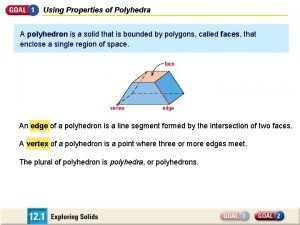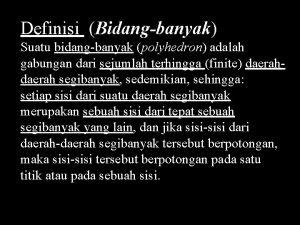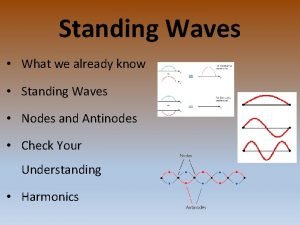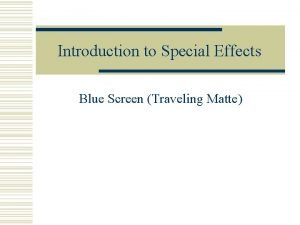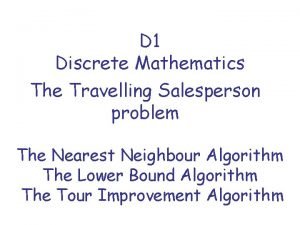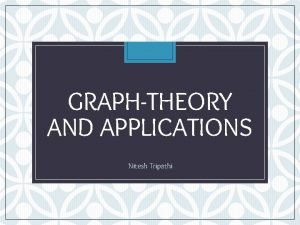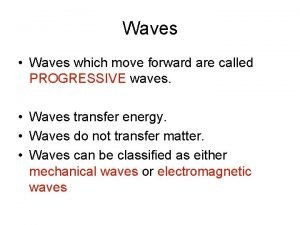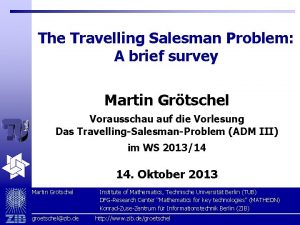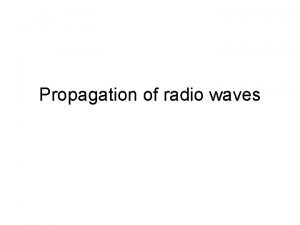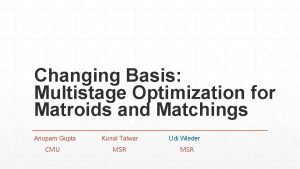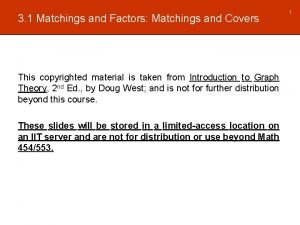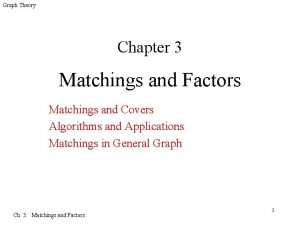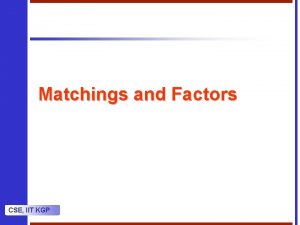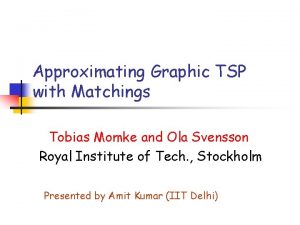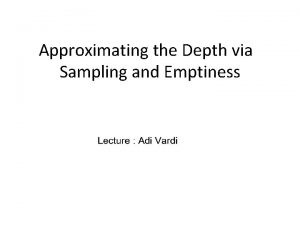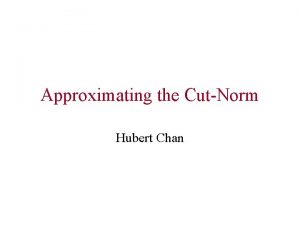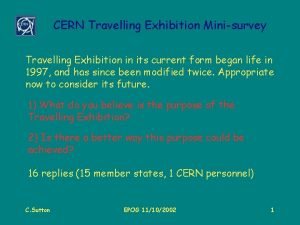Matchings Matroids and Polyhedra for Approximating the Travelling







































- Slides: 39

Matchings, Matroids and Polyhedra for Approximating the Travelling Salesman Problem András Sebő CNRS (G-SCOP), Univ. Grenoble Alpes



The Salesman and the Postman The (Travelling) Salesman Nodes = Cities Do all the cities and come back ! NP-hard (Karp, 1972) The (Chinese) Postman Edges = streets Do all the streets and come back ! In P (Edmonds, Johnson 1973)

Optimal orders Metric: triangle inequality, satisfied by reasonnable applications, without it: even approx is hard TSP : s=t s-t-Path Travelling Salesman Problem INPUT : V «cities» , s , t V, c: V V IR+ metric OUTPUT: shortest s-t -Hamiltonian path OPT(c) P(V, s, t) = { x IR+E: x( (W)) ≥ 2, ≠ W V, s, t W or 1, if s, t separated by W = on vertices (1 for s, t ; else 2 )} min c. Tx LIN(c) s s t t t

Approximation and Integrality ratio For a minimization problem - the approximation ratio is at most if a solution of value at most OPT can be found in polynomial time - the integrality gap is at most if for all c: V V IR+ , OPT(c) / LIN(c) . . . 1 1/2 s=t 1 2 . . . k-1 s t Famous Conjectures: integrality gap and approximation ratio « = »

A reformulation PATH TSP INPUT : V cities, s , t V, c: V V IR+ metric OUTPUT: shortest s, t Hamiltonian path , s , t , s Each vertex exactly once By Euler’s theorem there is an Eulerian traill. at least once - sparse + degree parity - has a cardinality case : graph s-t path TSP , t - graph theory - polyhedra - LP does not have to restrict c SHORTEST {s, t}-tour INPUT : G=(V, E) graph s , t V, c: E IR+ metric OUTPUT: shortest s-t-Eulerian submultigraph in G. Multiplicities 0, 1 or 2

Tours Trail by Euler’s thm and shortcut : Hamiltonian cycle for metric closure : tour in the original G=(V, E) s=t This kind of deletion is explored in a clever way by Mömke & Svensson (2011) {s, t}-tour : connected (on V = spanning) all degrees but s, t even (s-t-Eulerian) subgraph of 2 E tour : {s, t}-tour with s=t

m et ric s

Summary of improvements 2012 -2017 TSP, s-t-path TSP Graph and general versions

Best example for Integrarlity gap Recent Progress A. S. , Vygen 2014 Christofides 1976 A. S. , van Zuylen, Nov. 2016 Hoogeveen 1991 A. S. , Vygen 2014 Cheriyan, A. S. , Szigeti (1999)

GAPS past cycle or path cycle (s=t) cardinality or weights Cardinality (graph metrics) general metrics Gamarnik, Lewenstein, Sviridenko (2005): 3/2 - for cubic 3 -connected Boyd, Sitters, van der Ster, Stougie (2011): 4/3 for cubic Oveis, Gharan, Saberi, Singh (2011) : 3/2 - Mömke, Svensson (2011) : 1. 461… Mucha (2011) : 13/9=1. 444… (s, t)-path Hoogeveen (1991) 5/3 An, Kleinberg, Shmoys 2011 1. 578 … Hoogeveen (1991) 5/3 Christofides CHR, 1976 1. 5 An, Kleinberg, Shmoys 2011 “AKS” 1. 619 … Sebő (2012), 1. 6 Vygen(2015) 1. 599 Vygen(2016) 1. 566

4/3 for 2 -ECSS new cycle or path GAPS cycle (s=t) (s, t)-path cardinality or weights Cardinality (graph metrics) Sebő, Vygen SV 12, Jan 2012 Gao: simple proof , march 2013 Sebő, Vygen SV 12, 2012 1, 5 1. 4 Ear optimization with matroid intersection 3 2 Gao: simple proof 2013 1 4 general metrics Christofides CHR, 1976 1, 5 Sebő, van Zuylen SZ 16, April 2016 1, 5 + 1/34 Uses Gottschalk, Vygen ‘s «magic » (2015) Schalekamp, A. S. , Traub, van Zuylen (April 2017) conceptual improvements with matroid union

1 Matchings “Parity Correction” for cardinality cases of the TSP, s-t-path TSP and 2 -ECSS

The perfect matching polytope Def : G=(V, E) undirected graph. M E perfect matching (p. m. ) if the sets of endpoints of M partition V. Kőnig (1916) Jacobi (1890) Egerváry (1931) Birkhoff (1946) von Neuman (1952): If G is bipartite : conv ( M : M p. m. ) = {x IRE : x ( (v))=1, x 0 } If G is arbitrary : Edmonds (1965), add : if U V , |U| is odd x ( (U)) 1

Well-known interpretation as probability distribution Particular distributions (max entropy, or comb. restrictions)

Petersen’s theorem (1891) A graph is cubic if all of its degrees are 3. Theorem: G is a cubic graph G has no bridge G has a p. m.

Weighted generalization Exercise : Let G=(V, E) be cubic, w: E IR on the edges. Then a. If G is bipartite, or b. If G is arbitrary bridgeless There exists a p. m. of weight 1/3 w(E) 12 8 10 9 15 15 6 7 6 11 10 + 9 + 11 + 2 x 15 = 60 1/3 w(E) (w (E) = 179 ) 5 Bridgeless, but cannot be partitioned to 3 p. m.

A generalization of Matchings: T-joins, parity correction for the TSP J E(G) is a T-join, if T = set of odd degree vertices of J. Adding or deleting edges of J ( 1 in multiplicity) : v T The parity changes exactly in T Approximation and Integrality Gap for the TSP (Christofides-Wolsey) separates the problem into connectivity + parity correction

The parity correction polyhedron J G S G connected, |T| even T-join T : = V (= odd degree vertices of F) Theorem Edmonds, Johnson ’ 73 : conv (T-joins) + IR+n = Q+(G, T) : = {x IR+E x( (W)) ≥ 1, (W) is a T-cut, i. e. |W T| is odd} Trick : If x Q+(G, T), then c(modifying parity in T) ≤ c. T x

Christofides : connectivity & parity correction Christofides Tour : c-min spannicng tree F + parity correction (pc) TF-joins, where TF : ={v: d. F(v) is odd } Can be delet ed diconnect F s tour TF-join is a TF-join => pc ≤ 1/2 for (s, t)-tours 2/3 Wolsey ‘ 80 : x* P(G, s=t) , so x*/2 Q+(G, T) T, apply to T=TF

Thm : Christofides-type alg ≤ 5/3 -OPTLP c. Tx : = LIN , E[F ]=x F F(s, t) Proof: + gap E[F F(s, t )] = q = x - p corrects the parity (x + p) /2 is in Q+ x - p E[parity correction] ≤ p: = E[F(s, t)] TF F s {s, t} –join of F G t {s, t} TF -join

The problematic issue: narrow Cuts P(V, s, t) = { x IR+E: x( (W)) ≥ 2, ≠ W V, s, t W or 1, if s, t separated by W = on vertices (1 for s, t ; else 2 )} Fix x P(V, s, t) (eg optimal for some c) s s t t t Then x/2 Q+(s, t) x= Def: A cut Q : is narrow, if x (Q) < 2 1/3 s An example of Gao t 2/3 1 An, Kleinberg and Shmoys (‘ 11) : form a chain (submodular inequality)

2 Matroids Ears : connectivity anticipating parity correction, Graph TSP with matroid intersection General s-t-path TSP with matroid union Delta-matroids and uniform covers in 3

Matroid Union for the s-t-path TSP . . . 1 1/2 1 2 . . . k-1 s t s=t F. Schalekamp, A. S. , V. Traub, A. van Zuylen, April 2017 : Gottschalk and Vygen’s ‘magic’ convex combination with union of different matroids

2 ECSS Minimum cardinality 2 -Edge Connected Spanning Subgraph-TSP, graph-TSP paths Def: A graph G=(V, E) is 2 -edge-connected, if (V, E e ) is connected for all e E.

Ears G = P 0 +P 1 + P 2 + … + Pk P 6 P 3 P 5 P 7 P 4 P 9 2 -approx for 2 ECSS: delete 1 -ears! P 1 P 2 P 0 P 8 The longer the ears, the smaller the quotient n. of edges / vertices Exploited by Cheriyan, A. S. , Szigeti (1998) for a 17/12 -approx

Approximation of 2 -ECSS, graph-TSP paths Theorem: (A. S. , Jens Vygen, 2014 ) 2 -ECSS of cardinality 4/3 OPTLP 4/3 OPT of Graph-TSP 7/5 OPTLP of Graph s-t-path-TSP 3/2 OPTLP Sketch of algorithmic proof : 1. Find an ear-decomposition Minimizing the number of even ears (Frank, 1993), - Which include 2 -ears, - there is no other lower bound for the number of nontrivial ears.

Ear-splicing Cheriyan, A. S. , Szigeti (1998), A. S. , Vygen (2014) 2. Do ear-splicing until reaching a nice ear-decomposition, that is: - 1 -ears last, 2 -ears, 3 -ears «pendant» : only trivial ears (edges) come later - no edges between their inner vertices, - min number of even ears Advantage of 2 - and 3 -ears : their parity is ready for the TSP there is freedom to add any variant

« Rerout » short ears R: = internal vertices of short (2 - or 3 - ears) R versions Short ears are not efficient in terms of number of edges / n. of vertices, but - they are very flexible for changes ! - Their vertices have good parity R R G 0: = G - R We have to connect G-R, adding 1 version of every ear: This is exactly an R-Tour minimization problem. 3. Use matroid intersection to choose at most one version of ears to connect G-R with a max number of involved 3 - and 2 -ears

Matroid Intersection, Union Edmonds (1970) M = (S, F 1) , M = (S, F 2) matroids conv ( F : F Fi) = {x IRS : x (A) ri (A) for all A S } Max { |F| : F F 1 F 2 } max { 1 T x : x (A) ri (A) (i=1, 2) for all A S } Theorem (Edmonds 1970): max |F| = min r 1 (X) + r 2 (S X) F F 1 F 2 X S Polynomial algorithm , weights too, nice version : Frank (1981) Easily equivalent : matroid partition, matroid union, … Schrijver’s book

Exact solution of ear optimization R-Tour Minimization Input : G graph, R V(G), non-negative weights Output : Find a min weight R-Tour , that is, subgraph of 2 G where - all degrees of vertices in R are even - which is connected on V(G) NP-hard : for R=V(G) = the min weight R-tour problem Special case in P: R is an eardrum i. e. the components of G(R) are vertices or edges; weight cardinality. opt V(G) ≥ opt. R : = the opt of this problem

3 Polyhedra : Uniform covers tours, {s, t} tours, ATSP

Uniform Covers with Tours tour : Eulerian (connected , all degrees even) subgraph (V, F), F 2 E Fact : G= (V, E) undirected 3 -edge connected. Then 1 conv ( r : r {0, 1, 2}E is the incidence vector of a tour} Recall Christofides-Wolsey: For the price of ½ LP optimum the parities of degrees of a tree can be corrected. J G F T : = V (= odd degree vertices of F) T-joins Any fixed conv comb defines a tree valued random variable, Proof : 2/3 dominates a point of the spanning tree polytope 1/3 dominates x Edmonds, Johnson’s T –join polyhedron T. E (tree F + parity correction for F, i. e. a TF-join) 2/3 + 1/3

Can 1 be decreased to c < 1 in the ‘Fact’ ? YES: Haddadan, Newman, Ravi (2017) c= 18/19 Famous conjecture : G= (V, E) undirected: x IR+E , x(C) 2 on every cut (subtour elim) , Equivalent through Farkas ‘ Lemma Then 4/3 x conv (tours} (occurs in Carr Vempala 2001 ) Conjecture: G= (V, E) undirected 3 -edge connected, cubic. Then 8/9 conv ( x : x {0, 1, 2}E is the incidence vector of a tour} Sandwich : weaker than Famous, stronger than graph special case. Proof: 2/3 subtour , so using the Famous Conjecture : 4/3 x 2/3 = 8/9 conv (tours} Boyd, A. S. June 26, 2017 (IPCO) : fundamental: M matching G-M =squares <-> compatible Euler = Hamilton -> delta-matroids Theorem : 6/7 < 1 is a conv comb of tours for a `fundamental class’

s-t-tours : Can c > 1 be decreased to 1 ? Famous conjecture : G= (V, E) undirected : x IR+E , x(C) 1 on s-t cuts, 2 otherwise (subtour elimination) Then 3/2 x conv (s-t-tours} Theorem : Conjecture: G/{s, t} 3 -edge-connected. Then 1 conv ( x : x {0, 1, 2}E is the incidence vector of a tour} Proof: 2/3 subtour , so using the Famous Conjecture : 3/2 x 2/3 = 1 conv (tours} ATSP : Constant gap +approx (Svensson, Tarnawski, Végh, August Tour: Eulerian, connected 2017) Conjecture : Integrality gap 2, and approximation multisubgraph Problem : Eulerian, cubic, strongly 3 -arc-conn => tour of cardinality 2 n.

Drop in the ocean A. S. , van Zuylen Nov. 2016 Theorem: If G/{s, t} is 3 -edge-conn, 1 is a conv comb of {s, t}-tours. Proof : s shores of 2 -cuts form a chain and are pairwise disjoint An, Kleinberg, Shmoys 2011 s S T t d(S) + d(T) = d(S T)+ 2 d(ST , TS) 2 + 2 = 3 + 0 + 2, a contradiction 2/3 conv hull of spanning trees : delete the unique edges of trees in 2 -cuts and use them for parity correction to complete 1/3 1 . Because of the disjointness of cuts no need of reconnection !

Combopt from bird’s eyes … and what we use of it : P : individual methods orientations d e t c flows e r di und irec ted Matching, (poly) matroid Intersection, Bipartite matching b-matching, T-joins, union, … Orientations with parity, … Eg: packing arborescences, … distances in undir NP : s -h submod flows he ard c t conservative graphs pro pa ing LP l a ble s du i u v i x Matchoid, jump system m ris o u s : r e Ind , h pp a P

NOT YET THE END ! - Ultimate : 4/3 for tours, 3/2 for [s, t}-tours (get rid of 1/34) - direct proof for layered decomposition. Edmonds’ matr union - Uniform cover of 8/9 by tours in 3 -edge-connected cubic graphs - Can 1 be uniformly covered by s, t tours - Do directed Eulerian Trails have tours of size 2 n ? HAPPY BIRTHDAY ! Tom and Jayme
 Properties of polyhedrons
Properties of polyhedrons Polihedron adalah
Polihedron adalah Regular polyhedra
Regular polyhedra Approximating square roots to the nearest hundredth
Approximating square roots to the nearest hundredth Approximating calculations
Approximating calculations Nodes and antinodes
Nodes and antinodes Public facilities relate to people's
Public facilities relate to people's Commercial vehicle meaning
Commercial vehicle meaning Travelling movimiento de camara
Travelling movimiento de camara Traveling matte
Traveling matte Travelling salesman problem in discrete mathematics
Travelling salesman problem in discrete mathematics Presentation travelling
Presentation travelling Prefer doing something
Prefer doing something Savings verfahren
Savings verfahren Travelling camera
Travelling camera Last summer mike's elder brother
Last summer mike's elder brother Objectives of travelling
Objectives of travelling Past continuous of travel
Past continuous of travel A fireman turns on his hose and is knocked backwards.
A fireman turns on his hose and is knocked backwards. Tongue twister about travelling
Tongue twister about travelling Travelling salesman problem
Travelling salesman problem Let's warm up
Let's warm up Connector problem in graph theory
Connector problem in graph theory Progressive waves travelling disturbances that transfer
Progressive waves travelling disturbances that transfer Past continuous tense travel
Past continuous tense travel Helsgaun
Helsgaun Ionizee
Ionizee Fspos
Fspos Typiska drag för en novell
Typiska drag för en novell Nationell inriktning för artificiell intelligens
Nationell inriktning för artificiell intelligens Ekologiskt fotavtryck
Ekologiskt fotavtryck Varför kallas perioden 1918-1939 för mellankrigstiden
Varför kallas perioden 1918-1939 för mellankrigstiden En lathund för arbete med kontinuitetshantering
En lathund för arbete med kontinuitetshantering Underlag för särskild löneskatt på pensionskostnader
Underlag för särskild löneskatt på pensionskostnader Personlig tidbok fylla i
Personlig tidbok fylla i Sura för anatom
Sura för anatom Förklara densitet för barn
Förklara densitet för barn Datorkunskap för nybörjare
Datorkunskap för nybörjare Tack för att ni lyssnade bild
Tack för att ni lyssnade bild Debattinlägg mall
Debattinlägg mall
